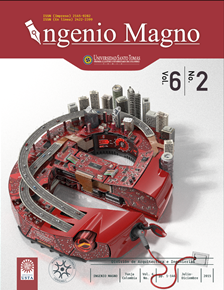DRAM size independence in single-core processors using gem5
Main Article Content
Abstract
Downloads
Article Details
DECLARATION OF ORGINIALITY OF SUBMITTED ARTICLE
With this document, I/We certify that the article submitted for possible publication in the institutional journal INGENIO MAGNO of the Research Center Alberto Magno CIIAM of the University Santo Tomás, Tunja campus, is entirely of my(our) own writing, and is a product of my(our) direct intellectual contribution to knowledge.
All data and references to completed publications are duly identified with their respective bibliographical entries and in the citations thus highlighted. If any adjustment or correction is needed, I(we) will contact the journal authorities in advance.
Due to that stated above, I(we) declare that the entirety of the submitted material is in accordance with applicable laws regarding intellectual and industrial property, and therefore, I(we) hold myself(ourselves) responsible for any complaint related to it.
If the submitted article is published, I(we) declare that I(we) fully relinquish publishing rights of the article to the University Santo Tomás, Tunja campus. As remuneration for this relinquishment of rights, I(we) declare my(our) agreement to receive two (2) copies of the edition of the journal in which my(our) article appears.
References
ARM (2013). Cortex A8 Technical Reference Manual. Revision: R2p1. http://infocenter.arm.com/help/index. jsp?topic=/com.arm.doc.ddi0344i/index.html (2013).
C. Augustine, C., X. Mojumder, X, H. Fong, H, S. Choday, S., P. Park, P. and & K. Roy, K. (2012). STT-MRAMs for future universal memories: perspective and prospective. Proc. of 2012 28th Int. Conf. on Microelectronics, 349355.
Inc. Cadence Design Systems (2013a). Cadence design ip: Wide-i/o controller. Tech. Rep.
Inc. Cadence Design Systems (2013b). Sources of error in full-system simulation. Advanced Computer Architecture Laboratory, Michigan: University of Michigan, Advanced Computer Architecture Laboratory..
Fernando Endo, F., Damien Couroussé, D. & and Charles, H.P.. Henri-Pierre (2014). Microarchitectural simulation of in-order and out-of-order arm microprocessors with gem5. International Conference on Embedded Computer Systems: Architectures, Modeling, and Simulation (SAMOS XIV).
Xuanyao Fong, X. and& Kaushik Roy, K. (2013). Lowpower robust complementary polarizer STT-MRAM (CPSTT) for on-chip caches. West Lafayette: Purdue University.
Hansson, A., Agarwal, N., Kolli, A., Wenisch, T. & and Udipi, A. (2014). Simulating dram controllers for future system architecture exploration. Proceedings of the International Symposium on Performance Analysis of Systems and Software (ISPASS).
David Money Harris, D. and& Sarah L. Harris, S. (2007).. Digital Design and Computer Architecture. California: Elsevier., inc.1, 2007.
John Hennessy, H. and& David. Patterson, D. . Computer Organization and Design (2009). The hardware software interface (4th ed.). California. Elsevier inc.
Hennessy, H. & Patterson, D. (2012). Computer architecture: a quantitative approach (2012). (5th ed.). John Hennessy and David. Patterson. California:. Elsevier inc.
Jacob, B. and D. Wang, D. (2007). Memory Systems: Cache, DRAM, Disk. (2007). B. California:. Morgan Kaufmann Publishers Inc.
Jain, P. rachi and& Wadhawan, J. anakrani (2014). Desing and comparative analysis of SRAM cell structures using 0.5 nm technology. International Journal of Computer Applications, 87(3)..
Rainer Leupers, R. and& Olivier Temam, O. (2007). .Processor and system-on- chip simulation. (2007). USA. Springer.
Nathan, B. et al. (2011). The gem5 Simulator. (2011). Recuperado de http://research.cs.wisc.edu/multifacet/ papers/can11_gem5.pdfACM SIGARCH Computar Architecture News.
Wulf, M. (1995). cKee. Hitting the memory wall: implications of the obvious. (1995). USA. Computer Architecture News, 23, 20-24.

